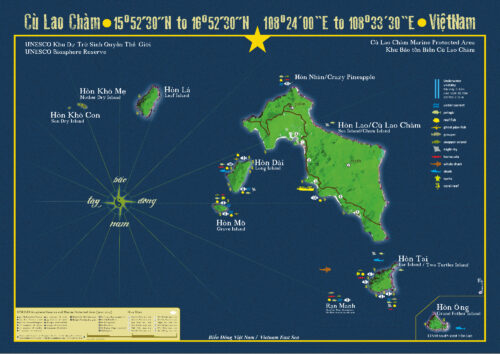Diving in the Cham Islands: Where Cultural Heritage Meets Ocean Treasures
Imagine a day that begins with a stroll through the ancient, lantern-lit streets of Hoi An and ends with you hovering weightlessly amidst soft coral gardens in turquoise water. That is the magic of the Cham Islands. More than just a beautiful cluster of islands, this is a UNESCO World Biosphere Reserve, a testament to the harmony between man and nature.
As an essential part of our Complete Guide to Diving in Vietnam, this in-depth Amadive article will bridge those two worlds. We will share our practical experiences for a fulfilling trip, from choosing the right dive sites to perfectly blending your underwater adventure with the irresistible charm of Hoi An’s heritage.

What Makes Diving in the Cham Islands a Unique Experience?
- Diving in a UNESCO Heritage Site: Experience the feeling of diving in a strictly protected ecosystem. This means healthier reefs and a strong commitment to sustainable tourism that you are helping to support.
- A Kingdom of Soft Corals and Anemones: While Nha Trang is strong in overall diversity and Phu Quoc stands out for its hard corals, the Cham Islands captivate with their lush carpets of colorful soft corals and anemones, creating a graceful, dreamlike landscape.
- The Perfect Blend of Diving and Culture: The proximity to Hoi An allows you to easily combine a day of ocean adventure with a relaxing evening exploring the unique cuisine and architecture of the ancient town.
- Ideal for Courses: The calm waters, shallow dive sites, and abundance of life at close range make the Cham Islands an excellent location to complete the exercises of an Open Water Diver course or specialty courses like Underwater Photography.
An In-Depth Look at the Top Dive Sites
Day trips from Hoi An or Da Nang will take you to the best spots around the islands.
1. Hon Dai (Long Island)
- Who is it for? All levels, especially clownfish lovers.
- The Experience: This is one of the most beloved dive sites. The dive begins on a shallow reef top at around 5 meters, then gently slopes down to a wall covered in soft corals at 20-25 meters. The highlight is a massive “garden” of anemones, home to dozens of clownfish families. Maintain perfect buoyancy to hover and observe their fascinating behavior.
- Marine Life Spotlight: Pink skunk clownfish, tomato clownfish, lionfish, yellow boxfish, and various soft corals.
2. Ran Mo (Cemetery Reef)
- Who is it for? All levels, interesting for those who like varied topography.
- The Experience: Ran Mo is a large area with diverse terrain, from sloping reefs to large boulders forming narrow swim-throughs. A dive here is like a leisurely stroll without a fixed route. You can take your time exploring the crevices, which often hide lobsters or groupers.
- Marine Life Spotlight: Butterflyfish, angelfish, parrotfish, and sometimes seahorses if you have a very keen eye and an experienced guide.
3. Hon Tai (Ear Island)
- Who is it for? Beginners and snorkelers.
- The Experience: With its shallow and clear waters, Hon Tai is a fantastic spot for relaxation. Large underwater boulders are covered with hard and soft corals, creating a beautiful scene even from the surface. This is where you can see dense schools of juvenile fish seeking shelter.
- Marine Life Spotlight: Schools of blue chromis, damselfish, and many colorful nudibranchs clinging to the rocks.
Planning Your Trip
- The Best Diving Season: Like Nha Trang, the ideal time to explore the Cham Islands is the dry season, from late February to September. The peak of the beautiful season is from May to late August, when the sea is flat and visibility is at its best.
- Water Conditions: The water temperature is warm, from 27°C to 30°C. Visibility can range from 10-20 meters and is sometimes affected by nearby rivers, especially after heavy rains.
- Advice from Amadive’s Experience: Most day trips include lunch at Bai Chong, one of the beautiful beaches on the Cham Islands. Enjoy a fresh seafood lunch and relax on the beach after your dives. It’s an essential part of the experience.
Frequently Asked Questions (FAQ)
- How long is the boat trip to the Cham Islands?
- By speedboat from Cua Dai harbor (Hoi An), it only takes about 20-25 minutes.
- Can I stay overnight on the island?
- Yes, the Cham Islands have several simple homestays. Staying overnight gives you a chance to experience the peaceful fishing village life and possibly dive early the next morning before the day-trippers arrive.
Conclusion: The Perfect Intersection
The Cham Islands offer a unique blend that few places can match: a protected marine ecosystem right next to a world cultural heritage site. It’s not just a dive trip; it’s a journey that enriches your entire Vietnam travel experience, connecting you with both its nature and its people.
